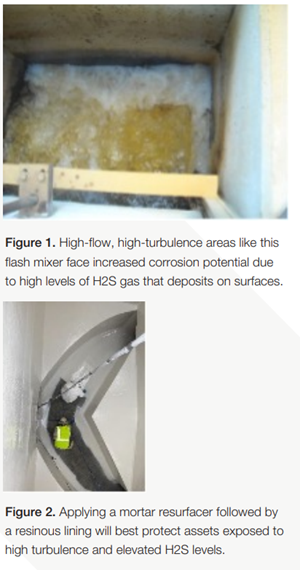November 2023 Vol. 78 No.11
Rehab Technology
How to extend longevity of underground concrete structures
By NASSCO Member John Sierzega, Sherwin-Williams Protective & Marine
(UI) — From precast manholes to cast-in-place lift stations and pump stations, concrete structures are found everywhere throughout underground sewer infrastructure. Installed below grade and left to serve their critical functions, many such assets are at the point of requiring rehabilitation and need attention before they deteriorate further and require full replacement.
Asset owners typically coat these structures from the outset to improve their lifecycle and resist attacks from hydrogen sulfide (H2S) and other corrosive substances found in sewer systems. These coatings include epoxies, polyureas, and other polymeric compounds. However, coatings will deteriorate over time, wearing away and exposing the concrete substrate to direct corrosive attacks. Paying attention to the critical details outlined below when coating underground concrete structures will result in the greatest potential for increased service life.
Prep surfaces properly
Surface preparation is the foundation for any successful concrete coating project. The goal is to prepare the surface to an acceptable level for the rehabilitation materials to adhere to the concrete and protect the structure. The process is not complicated. Contractors simply need to remove old coatings and any loose concrete, while ensuring a sufficient surface profile remains to enable the rehabilitation materials to adhere. This can be done with a pressure washer, grinder, or sand blaster and is usually done quickly. Still, there are some important considerations to follow.
Making termination points for coatings is one step that is often missed. Terminations allow for an impermeable ending edge of a coating system to ensure water and corrosive substances will have difficulty getting behind the system. They are often used when water will flow through the structure and when the coating system won’t be monolithic throughout the structure. Creating a proper termination point involves grinding or cutting in a ¼- inch x ¼-inch keyway around the area where the system will be terminated and then applying the material inside the keyway.
This keyway and the additional coating materials anchor the system deeper into the substrate so moisture or chemicals will have to penetrate a full ¼ inch deep at the perimeter before getting behind the coating system. Such termination points are especially important if back flushing will be done with a vac truck.
Jump on joints
Joints in precast structures can be an area of concern for concrete structure deterioration. Such joints are typically packed with a cementitious product during construction. But if movement has occurred, these areas may be cracked, which can lead to inflow and infiltration, erosion, and corrosion.
A different design detail may be needed for such areas. Applicators could add a keyway on each side of the joint and then honor the joint by filling it with a flexible chemical-resistant caulk such as a polysulfide sealant. They would first apply the rehabilitation system, or polymeric coating, followed by insertion of the flexible sealant. This option allows the joint to move without cracking, ensuring the area remains resistant to chemical attack.
This approach to joint rehabilitation is often used on lift stations that are covered with a precast lid, as thermal cycling happens at the top of the structure, increasing the likelihood that a joint may crack in that area. A crack itself is not a system failure, but rather an indicator that a design detail needs to be adjusted to maximize the structure’s service life.
Initiate full inspections
Even if a new coating looks good to the eye, inspections need to be performed. That includes traditional holiday inspections in which an electrified brush is moved over the entire coated surface to test the continuity of the coating. The brush will spark and beep anywhere it completes a circuit with the substrate under the coating system, indicating that the coating in those areas is not thick enough or may have a missed spot or “holiday” in the coating system. Feedback is based on the dielectric strength of the coating, with the tester set to the voltage for the minimum coating thickness required. Holiday detection is especially important in high H2S environments, including structures that have a turbulent flow (Figure 1). High levels of H2S often occur downstream of force main discharge structure, near siphons, or in interceptors with slow moving flow.
In addition, inspectors ought to do a simple sounding test on every project, which involves tapping on the system with a hammer or other object and listening to the feedback. A hollow sound may indicate the system is not properly bonded to the structure, which means water could get between the coating system and concrete substrate and lead to premature deterioration.
Following the above advice – and selecting optimal coatings for the environment (Figure 2) – will provide the greatest potential for longer asset service lives for underground concrete structures.
All images courtesy of The Sherwin-Williams Company unless otherwise noted.





Comments